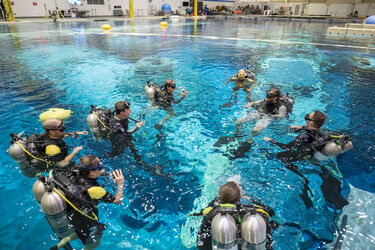Accept all cookies Accept only essential cookies See our Cookie Notice

About ESA
The European Space Agency (ESA) is Europe’s gateway to space. Its mission is to shape the development of Europe’s space capability and ensure that investment in space continues to deliver benefits to the citizens of Europe and the world.
Highlights
ESA - United space in Europe
This is ESA ESA facts Member States & Cooperating States Funding Director General Top management For Member State Delegations European vision European Space Policy ESA & EU Space Councils Responsibility & Sustainability Annual Report Calendar of meetings Corporate newsEstablishments & sites
ESA Headquarters ESA ESTEC ESA ESOC ESA ESRIN ESA EAC ESA ESAC Europe's Spaceport ESA ESEC ESA ECSAT Brussels Office Washington OfficeWorking with ESA
Business with ESA ESA Commercialisation Gateway Law at ESA Careers Cyber resilience at ESA IT at ESA Newsroom Partnerships Merchandising Licence Education Open Space Innovation Platform Integrity and Reporting Administrative Tribunal Health and SafetyMore about ESA
History ESA Historical Archives Exhibitions Publications Art & Culture ESA Merchandise Kids Diversity ESA Brand Centre ESA ChampionsLatest
Space in Member States
Find out more about space activities in our 23 Member States, and understand how ESA works together with their national agencies, institutions and organisations.
Science & Exploration
Exploring our Solar System and unlocking the secrets of the Universe
Go to topicAstronauts
Missions
Juice Euclid Webb Solar Orbiter BepiColombo Gaia ExoMars Cheops Exoplanet missions More missionsActivities
International Space Station Orion service module Gateway Concordia Caves & Pangaea BenefitsLatest
Space Safety
Protecting life and infrastructure on Earth and in orbit
Go to topicAsteroids
Asteroids and Planetary Defence Asteroid danger explained Flyeye telescope: asteroid detection Hera mission: asteroid deflection Near-Earth Object Coordination CentreSpace junk
About space debris Space debris by the numbers Space Environment Report In space refuelling, refurbishing and removingSafety from space
Clean Space ecodesign Zero Debris Technologies Space for Earth Supporting Sustainable DevelopmentApplications
Using space to benefit citizens and meet future challenges on Earth
Go to topicObserving the Earth
Observing the Earth Future EO Copernicus Meteorology Space for our climate Satellite missionsCommercialisation
ESA Commercialisation Gateway Open Space Innovation Platform Business Incubation ESA Space SolutionsLatest
Enabling & Support
Making space accessible and developing the technologies for the future
Go to topicBuilding missions
Space Engineering and Technology Test centre Laboratories Concurrent Design Facility Preparing for the future Shaping the Future Discovery and Preparation Advanced Concepts TeamSpace transportation
Space Transportation Ariane Vega Space Rider Future space transportation Boost! Europe's Spaceport Launches from Europe's Spaceport from 2012Latest

Columbus takes the plunge
Thank you for liking
You have already liked this page, you can only like it once!
A full-scale mock-up of the European Columbus laboratory is submerged into the Neutral Buoyancy Facility (NBF) at the European Astronaut Centre (EAC) in Cologne, Germany.
Before European astronauts fly to the International Space Station and work in the European laboratory module known as Columbus, they follow an intense training programme, which includes both wet and dry exercises on Earth.
The European Astronaut Centre has a neutral buoyancy facility – a water tank that is 10 metres deep and contains 3.7 million litres of water. This pool serves as a simulated environment for initial spacewalk training, and has enough space to submerge a replica of the Columbus laboratory module.
Columbus is ESA’s largest single contribution to the International Space Station, offering European scientists full access to conduct experiments in a weightless environment. It has room for ten payload racks, each hosting autonomous laboratories to support research.
Since spacewalks cannot be practised under genuine space conditions on Earth, simulating weightlessness underwater is an important aspect of astronaut training.
During their training, astronauts learn fundamental concepts and skills, including tethering to the Station, handling special tools, communicating with crewmates and the control room, and maintaining situational awareness in a complex and challenging environment.
This year, with five newly selected astronaut candidates commencing their basic training at EAC, the tank is in full use for scuba diving training and certification. This marks the initial step towards spacewalk training underwater.
ESA astronaut Andreas Mogensen is set to put his training into action during his first spacewalk. Andreas is currently living and working on the Space Station for his six-month Huginn mission.
During his spacewalk, Andreas will exit the Space Station alongside NASA astronaut Loral O’Hara. Andreas, who is currently serving as the Station's commander, will install a new high-definition camera while strapped to one of the Station’s robotic arm, Canadarm2. The duo will also check a new tool to connect and disconnect cables to the Alpha Magnetic Spectrometer (AMS-02).
Stay tuned for more information on Andreas's spacewalk.
-
CREDIT
ESA -
LICENCE
ESA Standard Licence

Deep dive across the pond

Columbus laboratory

A view of the European Columbus laboratory attached…

A view of the European Columbus laboratory installed…















 Germany
Germany
 Austria
Austria
 Belgium
Belgium
 Denmark
Denmark
 Spain
Spain
 Estonia
Estonia
 Finland
Finland
 France
France
 Greece
Greece
 Hungary
Hungary
 Ireland
Ireland
 Italy
Italy
 Luxembourg
Luxembourg
 Norway
Norway
 The Netherlands
The Netherlands
 Poland
Poland
 Portugal
Portugal
 Czechia
Czechia
 Romania
Romania
 United Kingdom
United Kingdom
 Slovenia
Slovenia
 Sweden
Sweden
 Switzerland
Switzerland

























